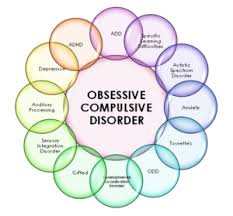Obsessive compulsive disorder (OCD) is an anxiety disorder that affects two to three percent of the population (more than 500,000 Australians). It usually begins in late childhood or early adolescence. People with OCD experience recurrent and persistent thoughts, images or impulses that are intrusive and unwanted (obsessions). They also perform repetitive and ritualistic actions that are excessive, time-consuming and distressing (compulsions). People with OCD are usually aware of the irrational and excessive nature of their obsessions and compulsions. However, they feel unable to control their obsessions or resist their compulsions.
Symptoms of OCD – obsessions
Obsessions are usually exaggerated versions of concerns and worries that most people have at some time. Common obsessions include:
- fear of contamination from germs, dirt, poisons, and other physical and environmental substances
- fear of harm from illness, accidents or death that may occur to oneself or to others. This may include an excessive sense of responsibility for preventing this harm
- intrusive thoughts and images about sex, violence, accidents and other issues
- excessive concern with symmetry, exactness and orderliness
- excessive concerns about illness, religious issues or morality
- needing to know and remember things.
Obsessions may be constantly on a person’s mind. They may also be triggered by physical objects, situations, smells or something heard on television, radio or in a conversation. Obsessive fears usually move beyond a specific trigger – for example, a bottle of coolant – to include anything that might look like it or have been near it, such as cars, car keys, a puddle on the road, supermarket shelves and petrol stations.
Obsessions can change in nature and severity and do not respond to logic. Obsessional anxiety leads to vigilance for possible threats, and a compelling need for certainty and control. Obsessions can produce feelings ranging from annoyance and discomfort to acute distress, disgust and panic.
Symptoms of OCD – compulsions
Compulsions can be behavioural (actions) or mental (thoughts). Compulsions are repetitive actions that are often carried out in a special pattern or according to specific rules. Compulsions are usually performed to try and prevent an obsessive fear from happening, to reduce the anxiety the obsessive thought creates, or to make things feel ‘just right’.
Common compulsions include:
- excessive hand washing, showering and tooth brushing
- excessive cleaning and washing of house, household items, food, car and other areas
- excessive checking of locks, electrical and gas appliances, and other things associated with safety
- repeating routine activities and actions such as reading, writing, walking, picking up something or opening a door
- applying rigid rules and patterns to the placement of objects, furniture, books, clothes and other items
- touching, tapping or moving in a particular way or a certain number of times
- needing to constantly ask questions or confess to seek reassurance
- mentally repeating words or numbers a certain number of times, or concentrating on ‘good’ or ‘safe’ numbers
- replacing a ‘bad thought’ with a ‘good thought’.
Usually compulsions become like rituals; they follow specific rules and patterns, and involve constant repetitions. Compulsions give an illusory sense of short-term relief to anxiety. However, they actually reinforce anxiety and make the obsessions seem more real, so that the anxiety soon returns.
OCD can have a profound effect on a person’s life
Compulsions and obsessions may take up many hours of a person’s day and can interfere with family and social relationships. They can also have a negative effect on education and employment.
As OCD becomes more severe, ‘avoidance’ may become an increasing problem. The person may avoid anything that might trigger their obsessive fears. OCD can make it difficult for people to perform everyday activities like eating, drinking, shopping or reading. Some people may become housebound. OCD is often compounded by depression and other anxiety disorders, including social anxiety, panic disorder and separation anxiety.
People with OCD are often acutely embarrassed about their symptoms and will put great effort into hiding them. Before the disorder is identified and treated, families may become deeply involved in the sufferer’s rituals, which can cause distress and disruption to family members.
Causes of OCD
The causes of OCD are not fully understood There are several theories about the causes of OCD, including:
- Compulsions are learned behaviours, which become repetitive and habitual when they are associated with relief from anxiety.
- OCD is due to genetic and hereditary factors.
- Chemical, structural and functional abnormalities in the brain are the cause.
- Distorted beliefs reinforce and maintain symptoms associated with OCD.
It is possible that several factors interact to trigger the development of OCD. The underlying causes may be further influenced by stressful life events, hormonal changes and personality traits.
Treatment for OCD
Treatment for OCD can include:
• psychological treatments such as cognitive behaviour therapy
• anxiety management techniques
• support groups and education
• medications.
Psychological treatment such as cognitive behaviour therapy can improve symptoms, and this improvement is often maintained in the long term.
Cognitive behaviour therapy
Cognitive behaviour therapy aims to change patterns of thinking, beliefs and behaviours that may trigger anxiety and obsessive compulsive symptoms. This therapy uses education to promote control over symptoms. The education includes information that helps to expose myths about the causes of OCD.
Part of the therapy involves gradually exposing the person to situations that trigger their obsessions and, at the same time, helping them to reduce their compulsions and avoidance behaviours. This process is gradual and usually begins with less feared situations. The exposure tasks and prevention of compulsions are repeated daily and consistently until anxiety decreases. Over time, this allows the person to rebuild trust in their capacity to manage and function, even with anxiety. This process is known as exposure and response prevention (ERP).
Cognitive behaviour therapy should be undertaken with a skilled, specialist mental health professional. Over-use of alcohol, drugs and some medications may interfere with the success of this type of treatment.
Anxiety management techniques for OCD
Anxiety management techniques can help a person to manage their own symptoms. Such techniques can include relaxation training, slow breathing techniques, mindfulness meditation and hyperventilation control. These techniques require regular practice and are most effective if used together with a cognitive behaviour therapy treatment program.
OCD support groups and education
Support groups allow people with OCD and their families to meet in comfort and safety, and give and receive support. The groups also provide the opportunity to learn more about the disorder and to develop social networks.
Medication for OCD
Some medications, especially antidepressants that affect the serotonin system, have been found to reduce the symptoms of OCD. This medication can only be prescribed by a medical practitioner.
Side effects of antidepressants may include nausea, headaches, dry mouth, blurred vision, dizziness and tiredness. These effects often decline after the first few weeks of treatment. If your side effects are severe or last for a long time, you should discuss this with your doctor.
It usually takes several weeks for medication to deliver any effects. When reducing or stopping medication, the dose should be reduced slowly under medical supervision.
Research has shown that children with rheumatic fever who develop Sydenham’s chorea are at higher risk of OCD, so early treatment with antibiotics may reduce the chances of future obsessive thinking.
Hospitalisation for OCD
Assessment and treatment in hospital can be helpful for some people, particularly when symptoms are severe. A stay in hospital may last from several days to a few weeks.
Self-help tips for people living with OCD
There are many ways that you can help yourself in addition to seeking therapy. Some suggestions are:
- Refocus your attention (like doing some exercise or playing a computer game). Being able to delay the urge to perform a compulsive behaviour is a positive step.
- Write down obsessive thoughts or worries. This can help identify how repetitive your obsessions are.
- Anticipate urges to help ease them. For instance, if you compulsively check that the doors are locked, try and lock the door with extra attention the first time. When the urge to check arises later, it will be easier to re-label that urge as ‘just an obsessive thought’.
- Set aside time for a daily worry period. Instead of trying to suppress obsessions or compulsions, set aside a period for obsessing, leaving the rest of the day free of obsessions and compulsions. When thoughts or urges appear in your head during the day, write them down and postpone them to your worry period – save them for later and continue to go about your day.
- Take care of yourself. Although stress doesn’t cause OCD, it can trigger the onset of obsessive and compulsive behaviour or make it worse. Try to practice relaxation (such as mindfulness meditation or deep breathing) techniques for at least 30 minutes a day.
Where to get help
- Anxiety Recovery Centre Victoria. Tel. (03) 9830 0533 or 1300 ANXIETY (269 438)
- SANE Australia. Tel. 1800 18 SANE (7263)
- Australian Psychological Society Referral Service. Tel. (03) 8662 3300 or 1800 333 497
- Your doctor







